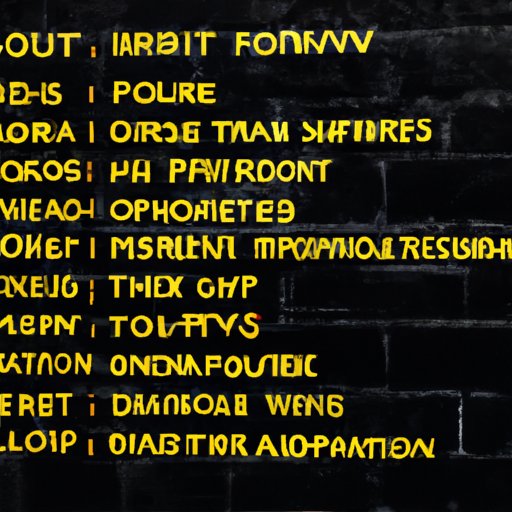Introduction
Non-fungible tokens (NFTs) are digital assets that are secured with blockchain technology and stored on the Ethereum network. They represent ownership of a unique item or asset, such as a piece of artwork, a collectible card, or a virtual property. NFTs have recently become popular among investors who are looking for new opportunities to diversify their portfolios. In this article, we will explore the benefits and risks of investing in NFTs, examine the impact they have had on the art world, analyze the potential profitability of NFTs as an investment, investigate the regulatory environment for NFTs, and compare NFTs to other types of investments.

An Overview of NFTs: What They Are and How They Work
NFTs are digital assets that are secured with blockchain technology and stored on the Ethereum network. They represent ownership of a unique item or asset, such as a piece of artwork, a collectible card, or a virtual property. NFTs use cryptographic hashing to verify authenticity and prove ownership, which makes them immutable and indestructible. This means that they cannot be counterfeited or destroyed, and they can be easily transferred between users. NFTs can also be used to track the provenance of physical objects, allowing buyers to know the history of the item they are purchasing.
There are several different types of NFTs. The most common type is the ERC-721 token, which is used to represent ownership of a unique item, such as a piece of artwork or a collectible card. There are also ERC-1155 tokens, which are used to represent ownership of multiple items, such as a collection of virtual properties. Finally, there are ERC-20 tokens, which are used to represent ownership of a fungible asset, such as a cryptocurrency.
The technology behind NFTs is complex and requires a certain level of technical knowledge to understand. At its core, NFTs use smart contracts that are built on the Ethereum blockchain. These smart contracts contain code that defines the rules and regulations of the NFT, such as who owns it, who can transfer it, and what happens when it is transferred. This code is then stored on the Ethereum blockchain, which is a distributed ledger that is maintained by a network of computers around the world.

Examining the Benefits and Risks of Investing in NFTs
Investing in NFTs has the potential to offer a variety of benefits, including diversification, liquidity, and access to unique assets. For example, NFTs can provide investors with an opportunity to diversify their portfolios by investing in unique digital assets that may not be available through traditional investments. Additionally, NFTs can offer investors greater liquidity than many traditional investments, as they can be easily bought and sold on secondary markets. Finally, NFTs can provide investors with access to unique assets that may not be available through traditional investments, such as rare pieces of art or virtual properties.
However, there are also potential risks associated with investing in NFTs. For example, the technology behind NFTs is still relatively new and untested, meaning there is no guarantee that the asset will hold its value over time. Additionally, there is a lack of regulation and oversight of the NFT market, meaning that investors may be exposed to fraudulent or deceptive practices. Finally, the secondary market for NFTs is still relatively small and illiquid, meaning that investors may have difficulty finding buyers for their NFTs.
Exploring the Impact of NFTs on the Art World
The growing popularity of NFTs has had a significant impact on the art world. NFTs have allowed artists to tokenize their work, meaning they can create digital copies of their artwork and sell them as NFTs. This has opened up new avenues for artists to monetize their work, as they can now sell digital copies of their artwork to buyers around the world. Additionally, NFTs have increased accessibility for artists, as buyers can now purchase artwork without having to physically travel to galleries or attend auctions. Finally, NFTs have enhanced the value of artwork, as buyers can now purchase original works of art that are authenticated and tracked on the blockchain.

Analyzing the Potential Profitability of NFTs as an Investment
When evaluating the potential profitability of NFTs as an investment, there are several factors to consider. First, NFTs have the potential to appreciate significantly in value over time, as the demand for them has been increasing rapidly in recent years. Additionally, NFTs can offer investors a high degree of liquidity, as they can be easily bought and sold on secondary markets. Finally, NFTs can provide investors with access to unique assets that may not be available through traditional investments, such as rare pieces of art or virtual properties.
It is important to note, however, that investing in NFTs carries a certain degree of risk. As with any investment, there is no guarantee that the asset will hold its value over time. Additionally, the secondary market for NFTs is still relatively small and illiquid, meaning that investors may have difficulty finding buyers for their NFTs. Finally, there is a lack of regulation and oversight of the NFT market, meaning that investors may be exposed to fraudulent or deceptive practices.
Investigating the Regulatory Environment for NFTs
The regulatory environment for NFTs is still evolving, as governments around the world are beginning to recognize the need to regulate the market. Currently, most countries have laws that apply to digital assets, but they are often outdated and do not fully address the complexities of the NFT market. As such, there is a growing need for governments to develop new regulations that are specifically tailored to NFTs. Some of the potential regulations that could be implemented include KYC/AML requirements, investor protections, and taxation policies.
Comparing NFTs to Other Types of Investments
When considering whether to invest in NFTs, it is important to compare them to other types of investments. One of the most common comparisons is to cryptocurrencies, such as Bitcoin or Ethereum. While NFTs and cryptocurrencies both use blockchain technology, they differ in several key ways. Cryptocurrencies are fungible, meaning each unit is interchangeable, while NFTs are non-fungible, meaning each unit is unique. Additionally, cryptocurrencies are typically used as a medium of exchange, while NFTs are typically used to represent ownership of a unique item or asset.
Another comparison is to traditional investments, such as stocks or bonds. While traditional investments are generally considered to be less risky than NFTs, they also tend to be less profitable. Additionally, traditional investments are typically more liquid than NFTs, meaning investors may have an easier time selling their investments. Finally, traditional investments are highly regulated, meaning investors have more legal protections than they do with NFTs.

Understanding the Unique Tax Implications of Investing in NFTs
In addition to the potential benefits and risks of investing in NFTs, it is important to understand the unique tax implications of investing in NFTs. The Internal Revenue Service (IRS) has recently issued guidance on the taxation of NFTs, stating that they should be treated as property for tax purposes. This means that investors may be subject to capital gains taxes when they sell their NFTs, and they may also be required to report their NFT income on their tax returns. Additionally, some investors may be able to take advantage of certain tax strategies, such as deferring capital gains taxes or taking deductions for business expenses related to their NFT investments.
Conclusion
Non-fungible tokens (NFTs) have become increasingly popular among investors who are looking for new opportunities to diversify their portfolios. While investing in NFTs has the potential to offer a variety of benefits, including diversification, liquidity, and access to unique assets, it is important to understand the potential risks associated with investing in NFTs, such as the lack of regulation and oversight of the NFT market and the potential for fraud or deception. Additionally, investors should consider the impact that NFTs have had on the art world, the potential profitability of NFTs as an investment, the regulatory environment for NFTs, and how they compare to other types of investments. Finally, it is important to understand the unique tax implications of investing in NFTs, as investors may be subject to capital gains taxes when they sell their NFTs.
Overall, investing in NFTs can be a profitable endeavor if done correctly. However, it is important to understand the potential risks associated with investing in NFTs and to research the market thoroughly before making any decisions.
(Note: Is this article not meeting your expectations? Do you have knowledge or insights to share? Unlock new opportunities and expand your reach by joining our authors team. Click Registration to join us and share your expertise with our readers.)
